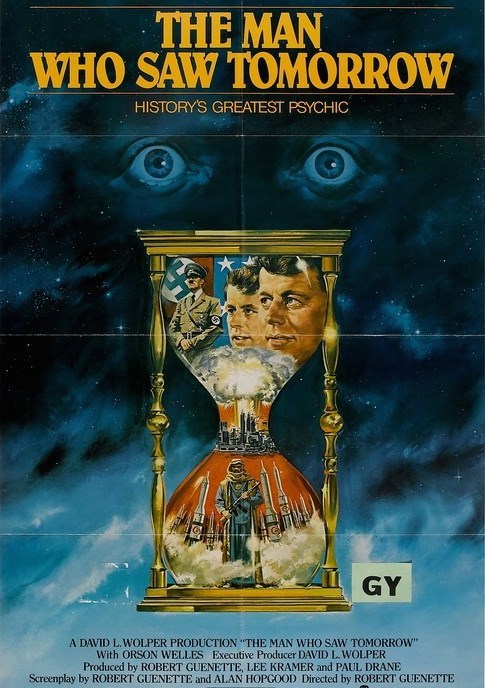Friday, July 23, 1982.
THE MAN WHO SAW TOMORROW. Co-written by Alan Hopgood. Music by William Loose and Jack Tillar. Co-written and directed by Robert Guenette. Running time: 88 minutes. Mature entertainment with no B.C. Classifier’s warning.
FRAU GOEBBELS WAS CONVINCED. She woke her husband Joseph, Hitler’s friend and chief propagandist, to tell him the news — Germany was fated to win the Second World War.
Nostradamus predicted it, she said, offering as evidence one of the l6th-century French seer’s cryptic quatrains.
It sounded good to the Reichsminister. To boost Nazi morale and unnerve the enemy, he had Hermann Goering’s Luftwaffe blanket Europe with leaflets proclaiming the inevitable triumph of fascism.
Winston Churchill could not let such a challenge go unanswered. He ordered His Majesty’s boffins to delve into the oracle’s book, Centuries 1555, and come up with some pro-British material.
Even the Americans got into the act. After the U.S. entered the war, M-G-M produced a series of Nostradamus Says So propaganda shorts making the case for an Allied victory.
Robert Guenette believes. A writer-director with such television documentary specials as 1976’s The Amazing World of Psychic Phenomena, Monsters! Mysteries or Myths (1974) and They’ve Killed President Lincoln! (1971) to his credit, Guenette was sure that the world was ready for an update on Michel de Nostredame, a.k.a. Nostradamus.
Like the Christian Bible and the works of Shakespeare, the writings of Nostradamus never seem to go out of print. My own edition, published in 1940, claims that he foresaw the French revolution, the great fire of London and the rise and fall of Napoleon.
Director Guenette’s 1981 film The Man Who Saw Tomorrow claims far more for the Provence-born futurist. A neatly edited package of feature film clips, newsreel footage, interviews and dramatic recreations, the picture sees events from the recent past and visions of the near future in his four-line prose quatrains.
Tragedy in the lives of the Kennedy brothers — Dallas, Los Angeles, Chappaquiddick — the fall of Iran’s Shah, the rise of Khomeini and the marriage of Prince Charles were all foretold, we’re told. Coming attractions, according to Guenette’s own “Nostradamus scholars,” include:
◼︎ a “great earthquake” accompanied by volcanic eruptions on the Pacific coast in May, 1988;
◼︎ a Soviet-Islamic alliance;
◼︎ a 27-year-long Third World War beginning in the 1990s;
◼︎ a nuclear attack on New York City in 1998;
◼︎ an eventual Soviet-American peace pact inaugurating 1,000 years of peace on Earth.
You don’t have to believe any of this, of course. Although the film claims "past evidence as proof of his accuracy," it offers no dissenting viewpoints — and we shouldn’t forget Frau Goebbels.
Then, too, there is just enough skepticism in the voice and manner of the film’s on-camera narrator, Orson Welles, to identify Guenette’s picture as, essentially, an entertainment film.
Like Welles’s own 1973 feature F for Fake, The Man Who Saw Tomorrow is best enjoyed for its component parts — oh, look, there’s Herbert Lom playing Napoleon, so this clip is from the 1956 War and Peace; there’s Rod Steiger, so this has to be Waterloo (1970) — and for its own outrageous chutzpah.
The above is a restored version of a Province review by Michael Walsh originally published in 1982. For additional information on this archived material, please visit my FAQ.
Afterword: YourNewsWire.com was among the many websites to suggest that Michel de Nostredame foresaw the outcome of the 2016 presidential election. Its report tells us that “Nostradamus predicted the inauguration of Donald Trump which would then be followed by World War 3, according to a rediscovered Quatrain. According to the 16th century French seer, Trump’s win over Clinton was predicted in Century III, Quatrain 81: ‘The great shameless, audacious brawler. He will be elected governor of the army: The boldness of his contention. The bridge broken, the city faint from fear.’ According to experts, the reference to ‘shameless, audacious brawler’ is Donald Trump’s bold style of campaigning. Also, ‘governor of the army’ refers to Trump’s role as commander-in-chief of the U.S. military.”
On the plus side, the "great earthquake" predicted in The Man Who Saw Tomorrow for 1988, and 1998 nuking of New York did not come to pass. (Although Nostradamus fans might claim that the seer really meant the 1980 eruption of Washington State's Mount St. Helens, and the 9/11 event of 2001.)
Massachusetts-born Robert Guenette made his directorial debut with 1969’s The Tree, a low-budget independent feature shot on location in New Jersey. It used a series of flashbacks to tell the story of an emotionally troubled drifter who returns to his home town. The style would become his trademark when, two years later, he moved into television to write, produce and direct his first docudrama, They’ve Killed President Lincoln! In 1975, he made a second theatrical feature, a “documentary” called The Mysterious Monsters that focused on such legendary creatures as the sasquatch and Loch Ness monster. With the exception of 1981’s The Man Who Saw Tomorrow, Guenette’s career was spent creating TV documentaries celebrating blockbuster movies, movie stars and sports heroes. In 1982, he was among the founders of the Los Angles-based International Documentary Association, a non-profit group that advocates for non-fiction filmmaking. Guenette died in 2003 at the age of 68.
